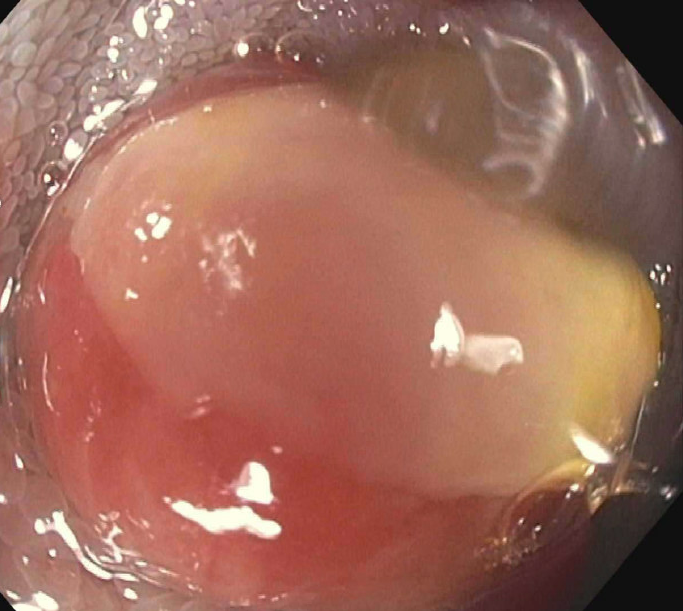Tuesday Poster Session
Category: Small Intestine
P6278 - Incidental Detection of a Well-Differentiated Neuroendocrine Tumor in the Terminal Ileum During Evaluation for Septic Shock
Tuesday, October 28, 2025
10:30 AM - 4:00 PM PDT
Location: Exhibit Hall
.jpg)
Amil Shah, DO
Parkview Medical Center
Pueblo, CO
Presenting Author(s)
Amil Shah, DO, Ahmad Zain, MBBS, Mustafa Nayeem, MD, Sung Yang, MD
Parkview Medical Center, Pueblo, CO
Introduction: Neuroendocrine tumors (NETs) of the gastrointestinal tract are uncommon, with the terminal ileum being a predominant site for well-differentiated forms. These tumors are often asymptomatic and incidentally discovered on imaging or endoscopic evaluation. Despite their indolent course, small bowel NETs can metastasize to lymph nodes and the liver, demonstrating the importance of early detection and treatment. This case highlights the incidental finding of a well-differentiated NET in an elderly male admitted for septic shock due to severe skin and soft tissue infection (SSTI) and pneumonia.
Case Description/
Methods: An 81-year-old male presented with cough, dyspnea, and right lower extremity erythema and edema. He was found to have septic shock secondary to SSTI and pneumonia requiring ICU admission for vasopressor support and broad-spectrum antibiotics. A CT abdomen/pelvis with contrast was performed during his workup, incidentally revealing a peripherally calcified 2.1 x 2.0 cm nonspecific intraperitoneal mass in the right lower quadrant, and a 2.5 x 3.0 cm enhancing endoluminal mass in the distal ileum near the ileocecal valve.
CT enterography confirmed an enhancing endoluminal mass in the terminal ileum with adjacent adenopathy and enlarged right external iliac chain lymph nodes. Once stabilized, colonoscopy with terminal ileal intubation identified a nearly obstructive 2.5 cm glistening, vascular polypoid lesion in the terminal ileum. Biopsies were obtained.
Pathology from the terminal ileum biopsy confirmed a well-differentiated neuroendocrine tumor (WHO grade 1). Surgery was consulted, and the patient underwent a right hemicolectomy.
The patient continues to improve post-operatively and remains hospitalized to date. Pathology results from the right hemicolectomy are currently pending.
Discussion: Incidental NETs can pose diagnostic and therapeutic challenges, particularly in critically ill, elderly patients. Small bowel NETs may have calcification and lymphadenopathy, as seen here. Colonoscopy with ileal intubation allows for direct visualization and biopsy of suspicious lesions.
Well-differentiated NETs are graded by mitotic index and Ki-67 proliferation rates, with grade 1 tumors having favorable prognoses. Surgical resection remains the mainstay of treatment for localized disease, reducing risks such as obstruction or carcinoid syndrome. This case emphasizes the need for prompt evaluation of incidental findings, even in critically ill or complex patients, to optimize long-term outcomes.

Figure: A glistening, smooth-surfaced, vascular, spherical, partially obstructing (~25 mm) polypoid lesion
Disclosures:
Amil Shah indicated no relevant financial relationships.
Ahmad Zain indicated no relevant financial relationships.
Mustafa Nayeem indicated no relevant financial relationships.
Sung Yang indicated no relevant financial relationships.
Amil Shah, DO, Ahmad Zain, MBBS, Mustafa Nayeem, MD, Sung Yang, MD. P6278 - Incidental Detection of a Well-Differentiated Neuroendocrine Tumor in the Terminal Ileum During Evaluation for Septic Shock, ACG 2025 Annual Scientific Meeting Abstracts. Phoenix, AZ: American College of Gastroenterology.
Parkview Medical Center, Pueblo, CO
Introduction: Neuroendocrine tumors (NETs) of the gastrointestinal tract are uncommon, with the terminal ileum being a predominant site for well-differentiated forms. These tumors are often asymptomatic and incidentally discovered on imaging or endoscopic evaluation. Despite their indolent course, small bowel NETs can metastasize to lymph nodes and the liver, demonstrating the importance of early detection and treatment. This case highlights the incidental finding of a well-differentiated NET in an elderly male admitted for septic shock due to severe skin and soft tissue infection (SSTI) and pneumonia.
Case Description/
Methods: An 81-year-old male presented with cough, dyspnea, and right lower extremity erythema and edema. He was found to have septic shock secondary to SSTI and pneumonia requiring ICU admission for vasopressor support and broad-spectrum antibiotics. A CT abdomen/pelvis with contrast was performed during his workup, incidentally revealing a peripherally calcified 2.1 x 2.0 cm nonspecific intraperitoneal mass in the right lower quadrant, and a 2.5 x 3.0 cm enhancing endoluminal mass in the distal ileum near the ileocecal valve.
CT enterography confirmed an enhancing endoluminal mass in the terminal ileum with adjacent adenopathy and enlarged right external iliac chain lymph nodes. Once stabilized, colonoscopy with terminal ileal intubation identified a nearly obstructive 2.5 cm glistening, vascular polypoid lesion in the terminal ileum. Biopsies were obtained.
Pathology from the terminal ileum biopsy confirmed a well-differentiated neuroendocrine tumor (WHO grade 1). Surgery was consulted, and the patient underwent a right hemicolectomy.
The patient continues to improve post-operatively and remains hospitalized to date. Pathology results from the right hemicolectomy are currently pending.
Discussion: Incidental NETs can pose diagnostic and therapeutic challenges, particularly in critically ill, elderly patients. Small bowel NETs may have calcification and lymphadenopathy, as seen here. Colonoscopy with ileal intubation allows for direct visualization and biopsy of suspicious lesions.
Well-differentiated NETs are graded by mitotic index and Ki-67 proliferation rates, with grade 1 tumors having favorable prognoses. Surgical resection remains the mainstay of treatment for localized disease, reducing risks such as obstruction or carcinoid syndrome. This case emphasizes the need for prompt evaluation of incidental findings, even in critically ill or complex patients, to optimize long-term outcomes.

Figure: A glistening, smooth-surfaced, vascular, spherical, partially obstructing (~25 mm) polypoid lesion
Disclosures:
Amil Shah indicated no relevant financial relationships.
Ahmad Zain indicated no relevant financial relationships.
Mustafa Nayeem indicated no relevant financial relationships.
Sung Yang indicated no relevant financial relationships.
Amil Shah, DO, Ahmad Zain, MBBS, Mustafa Nayeem, MD, Sung Yang, MD. P6278 - Incidental Detection of a Well-Differentiated Neuroendocrine Tumor in the Terminal Ileum During Evaluation for Septic Shock, ACG 2025 Annual Scientific Meeting Abstracts. Phoenix, AZ: American College of Gastroenterology.
